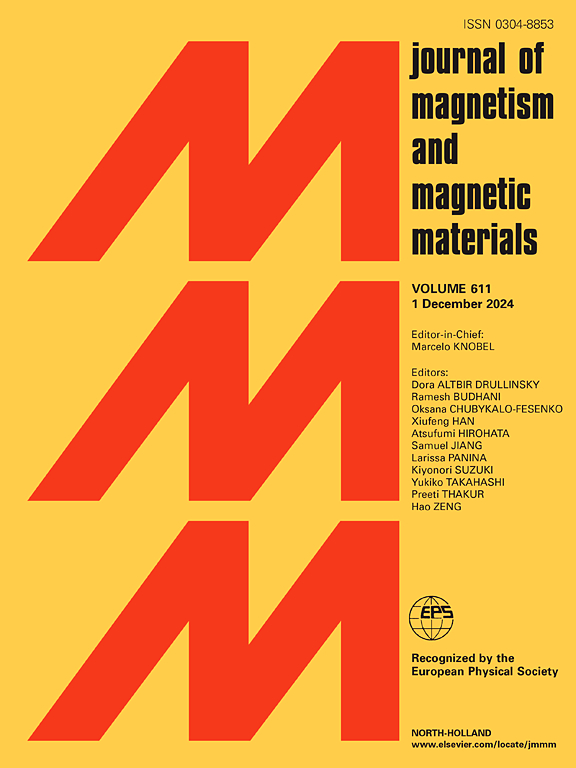Dzyaloshinskii-Moriya相互作用梯度驱动的基于skyrmion的能量高效泄漏集成火神经元
IF 2.5
3区 材料科学
Q3 MATERIALS SCIENCE, MULTIDISCIPLINARY
引用次数: 0
摘要
skyrmion的驱动机制对基于skyrmion的自旋电子器件的性能和能量效率有很大影响。利用直流电可以有效地利用自旋转移力矩(STT)和自旋轨道力矩(SOT)置换薄膜中的Skyrmions。然而,在这些器件中使用电流导致焦耳加热问题,这损害了它们在用于神经形态计算的自旋电子器件中的非挥发性优势。因此,有必要研究基于skyrmion的节能器件的替代驱动机制。本文研究了Dzyaloshinskii-Moriya相互作用(DMI)梯度下的skyrmion动力学。结果表明,DMI梯度是一种有效的驱动skyrmins的方法,具有skyrmins霍尔效应(SkHE)和高的纵向速度。此外,在室温下,利用DMI梯度设计了漏电集成点火(LIF)神经元,该神经元在不需要任何电流的情况下工作,具有高能效。该神经元利用DMI梯度集成在梯形纳米轨道上,通过纳米轨道本身的形状实现泄漏功能。这种设计消除了对外部刺激和额外硬件的需求,导致每尖峰91.363 fJ的低能耗。这为开发节能的基于skyrmion的设备开辟了一种新的方法来操纵skyrmion。本文章由计算机程序翻译,如有差异,请以英文原文为准。
Dzyaloshinskii–Moriya interaction gradient driven skyrmion based energy efficient leaky integrate fire neuron
The performance and energy efficiency of skyrmion-based spintronic devices can be greatly affected by the driving mechanism of skyrmion. Skyrmions in thin films can be efficiently displaced with spin-transfer torques (STT) and spin–orbit torques (SOT) using direct current. However, the utilization of current in these devices leads to the Joule heating issue, that compromises their non-volatility advantage in spintronic devices for neuromorphic computing. Therefore, it is necessary to investigate the alternative driving mechanisms for developing energy-efficient skyrmion based devices. In this work, skyrmion dynamics under Dzyaloshinskii–Moriya interaction (DMI) gradient is investigated. It is observed that the DMI gradient is an efficient way to drive the skyrmions with skyrmion Hall effect (SkHE) and a high longitudinal speed. Additionally, a leaky integrate-and-fire (LIF) neuron at room temperature is designed by employing DMI gradient that is energy efficient as it functions without the need for any current. This neuron utilizes a DMI gradient for integration on a trapezoidal-shaped nanotrack, achieving leaky functionality through the shape of the nanotrack itself. This design eliminates the need for external stimuli and additional hardware, resulting in low energy consumption of 91.363 fJ per spike. This opens a new alternative way to manipulate skyrmions for the development of energy-efficient skyrmion based devices.
求助全文
通过发布文献求助,成功后即可免费获取论文全文。
去求助
来源期刊

Journal of Magnetism and Magnetic Materials
物理-材料科学:综合
CiteScore
5.30
自引率
11.10%
发文量
1149
审稿时长
59 days
期刊介绍:
The Journal of Magnetism and Magnetic Materials provides an important forum for the disclosure and discussion of original contributions covering the whole spectrum of topics, from basic magnetism to the technology and applications of magnetic materials. The journal encourages greater interaction between the basic and applied sub-disciplines of magnetism with comprehensive review articles, in addition to full-length contributions. In addition, other categories of contributions are welcome, including Critical Focused issues, Current Perspectives and Outreach to the General Public.
Main Categories:
Full-length articles:
Technically original research documents that report results of value to the communities that comprise the journal audience. The link between chemical, structural and microstructural properties on the one hand and magnetic properties on the other hand are encouraged.
In addition to general topics covering all areas of magnetism and magnetic materials, the full-length articles also include three sub-sections, focusing on Nanomagnetism, Spintronics and Applications.
The sub-section on Nanomagnetism contains articles on magnetic nanoparticles, nanowires, thin films, 2D materials and other nanoscale magnetic materials and their applications.
The sub-section on Spintronics contains articles on magnetoresistance, magnetoimpedance, magneto-optical phenomena, Micro-Electro-Mechanical Systems (MEMS), and other topics related to spin current control and magneto-transport phenomena. The sub-section on Applications display papers that focus on applications of magnetic materials. The applications need to show a connection to magnetism.
Review articles:
Review articles organize, clarify, and summarize existing major works in the areas covered by the Journal and provide comprehensive citations to the full spectrum of relevant literature.
 求助内容:
求助内容: 应助结果提醒方式:
应助结果提醒方式:


